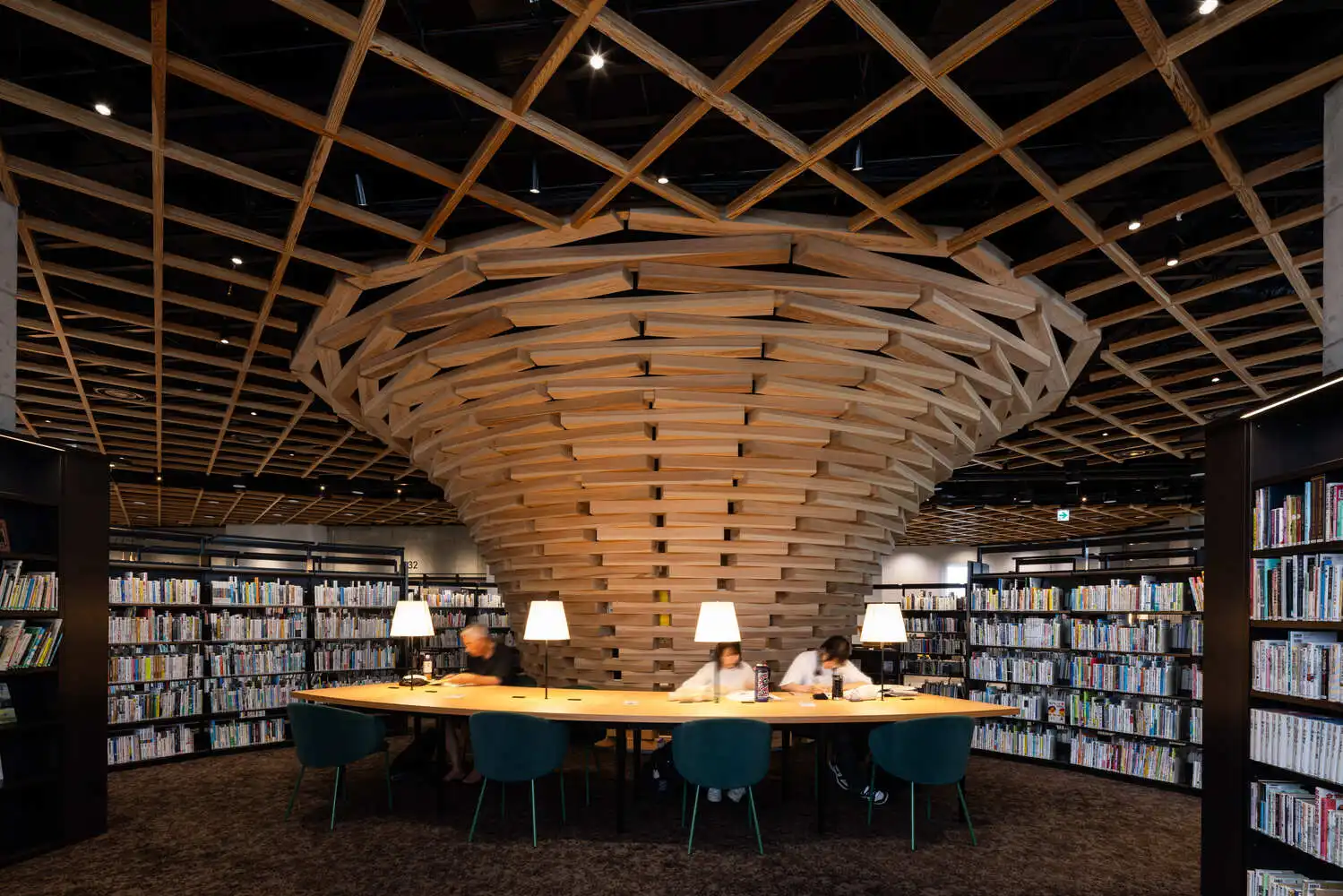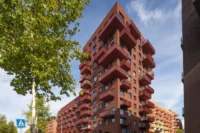Located in the heart of Nakagawa City, Fukuoka Prefecture, the Mirikaroden Nakagawa Cultural Complex stands as a vibrant civic hub where culture, learning, and community life intersect. The facility houses a public library, a multi-purpose concert hall, and a lifelong learning center, and is surrounded by complementary amenities, including a children’s center and an indoor swimming pool. Since its inception, the complex has been a focal point for residents—a place where education, recreation, and cultural engagement meet under one roof.
The recent renovation, led by Furumori Koichi Architectural Design Studio, rethinks not just the building’s physical environment but also the fundamental role of the library in contemporary life. The guiding vision emerged from a simple yet thought-provoking statement made during discussions with staff and city officials: “We need to change the way we think about libraries.”

A New Library Paradigm – “Library Everywhere”
The core design concept, “Library Everywhere,” challenges the conventional notion of a library as a single, clearly defined room. Instead, books and reading materials are deliberately dispersed throughout the complex, placed in locations where they can engage with and complement the activities taking place nearby.
For example, shelves stocked with books on music and the performing arts are located in the foyer adjacent to the concert hall, while literature on crafts and cooking can be found near the lifelong learning center. This integration creates a natural, thematic connection between the building’s programs and its literary resources—allowing visitors to encounter books in unexpected yet contextually relevant settings.
One particularly impactful change was the relocation of the magazine corner from deep inside the library to the main entrance hall. This subtle intervention increased visibility and accessibility, attracting passersby who might not have planned to visit the library but found themselves drawn in by the open and inviting presentation of materials.
Overcoming Initial Resistance
When first introduced, the “Library Everywhere” strategy met with cautious skepticism from some staff. There were concerns that integrating books into other program areas might blur functional boundaries, potentially making the music hall or learning center feel subsumed under the library’s identity.
However, as the project progressed, this integration revealed its benefits. The presence of curated book selections in diverse settings inspired staff to develop new connections between their events and related reading materials. Over time, the cultural complex began to operate as a cohesive whole, where each function—whether a concert, workshop, or lecture—could be enriched by relevant literary content.

More Than a Library – A Third Place
Beyond spatial distribution, the design embraces a deeper philosophy: the library as a “third place.” In urban sociology, the third place is a communal environment outside of home (first place) and work or school (second place) where people can gather, relax, and feel a sense of belonging.
During research for the project, the design team visited a small local library, where a librarian shared an insightful perspective: “Even if visitors don’t end up picking up a book, that’s perfectly fine.” This statement resonated deeply with the architects, shaping their approach to the cultural complex. The goal was to create a publicly funded, welcoming environment where the presence of books was not an obligation but an invitation—where the act of simply being there was valuable in itself.
In the renovated complex, this vision manifests through open, comfortable spaces designed for lingering. Seating areas encourage informal gatherings, while lighting and material choices—warm wood tones, soft illumination, and tactile finishes—reinforce a sense of comfort and inclusivity.
Spatial Atmosphere and Materiality
The interiors balance functionality with warmth, ensuring that the building feels both efficient and approachable. Bookshelves are integrated seamlessly into the architecture, acting not only as storage but also as spatial dividers and visual focal points. The use of natural wood adds a tactile quality, while carefully positioned lighting ensures that each reading nook, hallway, and gathering space is both inviting and practical.
This approach blurs the line between program areas, allowing the library to permeate every corner of the building without overwhelming other functions. Whether a visitor is attending a performance, taking part in a workshop, or simply passing through, they are continuously in dialogue with the library’s presence.

Civic Impact
The Mirikaroden Nakagawa Cultural Complex is no longer a collection of separate facilities operating under one roof—it has become a cohesive cultural ecosystem. By reimagining the library as an integrated, omnipresent feature, the renovation not only enhances accessibility to knowledge but also fosters spontaneous cultural engagement.
The project demonstrates that a library’s value extends beyond the books it houses. It can be an ever-present backdrop to community life, an environment where learning and leisure coexist naturally, and a space that quietly but powerfully enriches the experiences of everyone who enters.
In Nakagawa City, the library is no longer a destination hidden in one wing of a public building. It is an integral part of daily life—woven into the rhythm of the cultural complex, and by extension, into the fabric of the city itself.
Photography: Kyoko Omori
- Adaptive cultural space planning
- Book integration in public spaces
- Civic architecture Fukuoka Prefecture
- Community hub architecture
- Concert hall and library integration
- Cultural complex renovation Japan
- Furumori Koichi Architectural Design Studio
- Integrated library spaces
- Japanese civic architecture
- Library Everywhere concept
- Lifelong learning center design
- Lighting design for libraries
- Mirikaroden Nakagawa Cultural Complex
- Multi-purpose cultural center architecture
- Public library design
- Public space inclusivity
- Spatial design for cultural engagement
- Third place community design
- Urban cultural ecosystem design
- Warm wood interiors in architecture
























































Leave a comment